I tend to think of designers as dealing with either wind or seismic design, yet the Southeast region contains everything that Mother Nature can throw at a building. This includes high seismic areas along the New Madrid and Charleston faults, hurricanes along the Gulf and Eastern coast, and tornado prone areas throughout the South and Midwest. Sam participated in the investigation and was a co-author of the Damage Study and Future Direction for Structural Design Following the Tuscaloosa Tornado of 2011, which gives him some very recent experience with tornado damage. This week, Sam will be discussing a topic not often thought about by structural engineers – the importance of proper roof tile attachments. Here is Sam’s post:
According to recent studies by the Insurance Institute for Business Home and Safety (IBHS), roof coverings are a major problem area in wind-related events and account for 95% plus of home claims after the event.
Preventing roof tiles from becoming wind-borne debris in high wind regions is essential for several reasons, and may also have an effect on insurance premiums. In this post, I’d like to discuss two reasons that roof tiles can pose a significant threat to life safety:
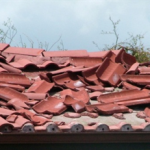
- Many designers rely on the weight of roof tiles to reduce the overall wind uplift effects on the structure. If the roof tiles do not remain in place during the wind event, then an under-designed wind uplift restraint system can exist.
- Roof tiles can essentially become missiles in a wind event, damaging nearby property and creating a significant and direct risk to public safety.
A Complete Load Path
Section 1604.4 in the International Building Code (IBC) requires a complete load path from point of origin to the load-resisting elements. For wind conditions, where does the wind uplift load path begin?
The roof tiles to roof decking attachment!
Designers often rely on the benefit of the weight of the roof tile to reduce uplift loads on the structure, but rarely (if ever) design or specify these connections. The code allows a portion of the roof dead load to be used to reduce uplift loads on the structure (60% of the typical 25 psf of dead load for tile roofs), so keeping it in place during a wind event is critical. Consequently, the attachment of the tile should also be included in the design by the project designer of record, or it should not be used to reduce uplift loads. This consideration is clarified in section 1605.3.2, “…only two-thirds of the dead load likely to be in place during a wind event shall be used…”.
Roof Systems
The design and construction of roof systems is addressed in section 1609.5 of the 2012 IBC. Section 1609.5.3 provides a method for determining wind loads on rigid tiles, as well as the minimum detailing and design requirements. In this section, equation 16-33 provides a means for calculating the minimum aerodynamic uplift moment, Ma (ft-lbf), acting to raise the tail of the tile.
Ma = qhCLbLLa[1.0 – GCp]
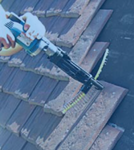
The use of this challenging equation should only be performed by a qualified designer and it should not just be left to the installer of a roof system to ensure the roof tiles are properly attached to the roof deck. Fortunately, the Florida Roofing, Sheet Metal and Air Conditioning Contractors Association (FRSA) teamed up with the Tile Roofing Institute to create the Concrete and Clay Roof Tile Installation Manual. The appendix of this document includes simple tables that assist the designer in determining the proper attachment of clay or concrete roof tiles to resist the aerodynamic uplift moment.
Wind-Borne Debris
Improper attachment of roof tile can also create powerful missiles in wind events. These missiles can pose a significant risk to life safety as they become wind-borne, either directly to the public, or through damage to nearby occupied structures, thereby reducing the ability of that structure to remain in place during the event. Both of these reasons make it essential for proper design and detailing of the connection of roof tiles to be incorporated into the design of the building by the project designer of record.
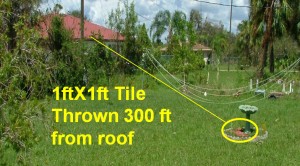
What are your thoughts? Let us know in the comments.
– Sam
What are your thoughts? Visit the blog and leave a comment!

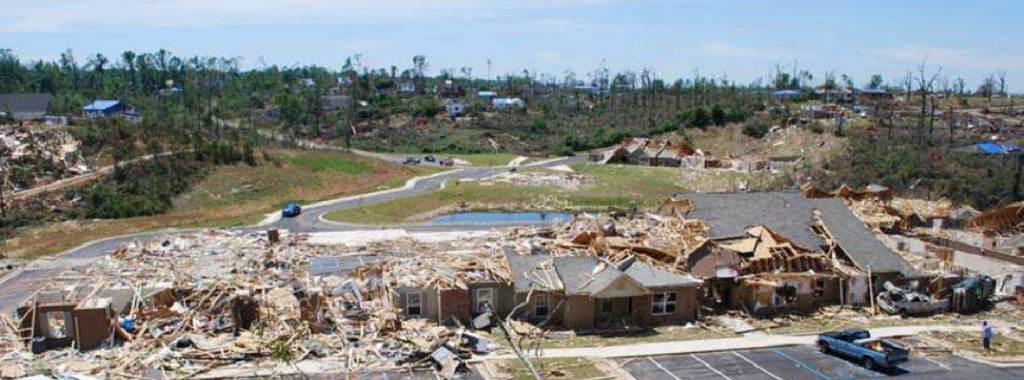




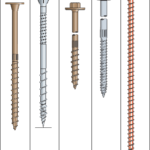
If I understand you correctly, you are recommending the structural engineer specify how roof tiles are attached to ensure they remain in place during a high wind event, or else not use the tile weight in resisting uplift forces. In my opinion this is far beyond what structural engineers do, or are able to do accurately. Surely we can rely on the roof industry to provide tile attachment requirements that are sufficient so their product actually performs. That is where the burden, and liability, should fall.
Thanks for your comment and I understand and appreciate your
concern regarding liability. The issue of responsibility for connections is
not unique to this application though. Truss anchorage is required to be
designed by the Project Engineer as stated in section 2.3.2.4 of the ANSI/TPI
2007 reference standard for metal plate connected trusses. Often project
engineers defer the design of the truss-to-wall uplift load back to the truss
engineer, and just provide tables of approved connections with allowable uplift
loads for the contractor to choose from when using the uplift reactions on the
approved truss certificates. This process (not perfect) could certainly be
utilized with roof covering attachment as well.
Regardless of where the burden falls, if as
designers we are relying on heavy roof material to assist in restraining uplift
on our structure; then we should also provide minimum loads, details and
general notes in our structural documents for these attachments.
First, I totally agree that the loads need to be addressed and
that attachment is the key to controlling the uplift. But as an engineer, the architect or the
owner is the one that chooses the roofing and it is quite often that the actual
roofing is not chosen till after the engineering is long past done and/or not
even chosen until the building is under construction in the case of high end
homes. All we know at the time of
engineering is the general type of roofing which we then make assumptions on
for loads. There are so many types of
tile alone and the attachment number and spacing, the coverage and the weigh is
different for each style of tile even with a manufacturer’s line. So my opinion is that the roofing
manufacturer’s need to provide this information and I think it ought to be in
the form of an ESR and some do. Take for
instance Hardie Siding (this is not a plug, just have had resent experience), they
have an ESR for all the types of siding they manufacture and address each of
the wall framing types and wind loading conditions and if you contact them about
an attachment question the first they direct you is to the ESR.
As you indicated, assumptions are often made on the weight of the roof tile to reduce uplift demands. Yet there are too many assumptions on the capacity side to prescribe minimum loads or details with minimum attachments required?
Requiring roof tiles to be attached in accordance with minimum details and loads in the structural documents and that the fasteners utilized be covered under an evaluation report is certainly a good start and should be considered by designers using the dead load benefit. One could create tables of the required quantity of approved fasteners (may be many types, sizes, and quantities) to be used for fastening the tiles based on an incremental uplift demand. The installer could then choose a product from your approved list when it comes time to choose the specific type of tile.